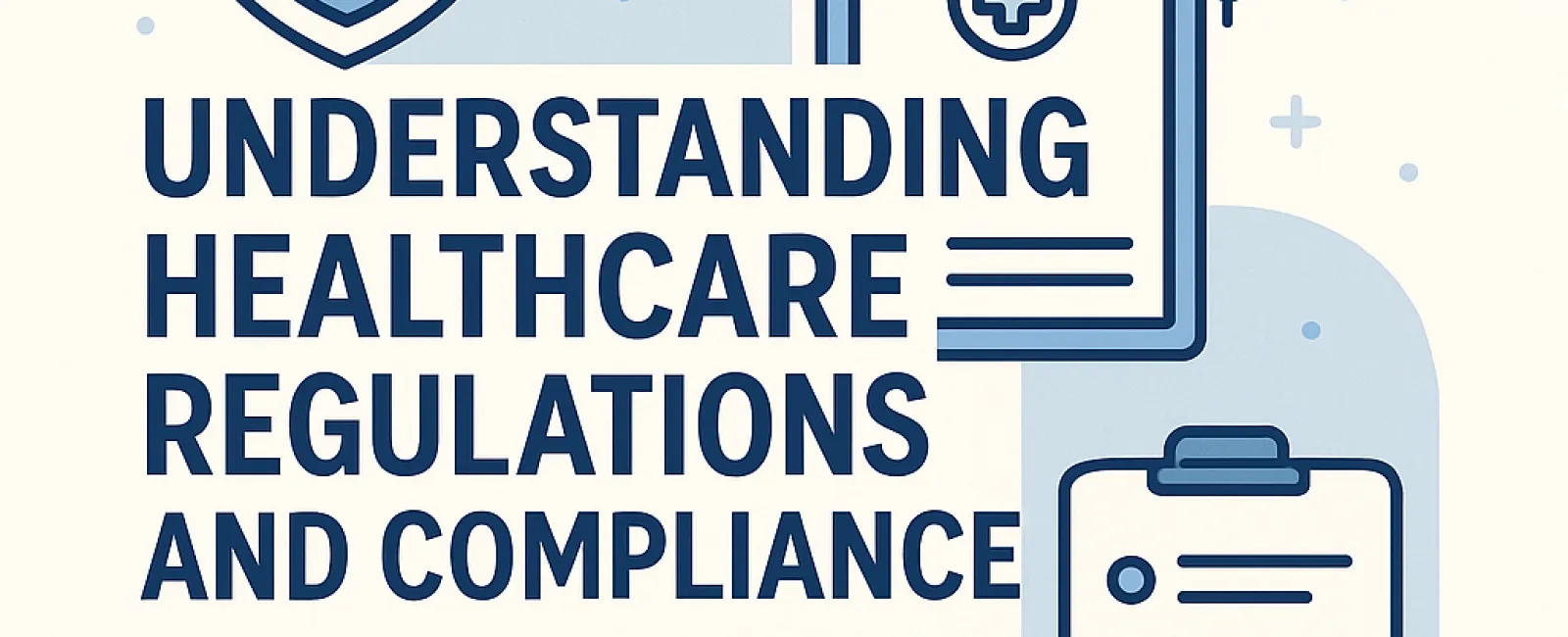What Are Healthcare Regulations?
Healthcare regulations are the rules and standards that shape nearly every part of the healthcare sector, from how doctors chart patient visits to how healthcare organizations protect sensitive data. These regulations are designed to promote patient safety, improve care quality, and ensure providers are held accountable for the services they deliver.
Definitions and Scope
At a glance, healthcare regulations and healthcare laws might sound like the same thing. But there's an important difference. Healthcare laws are passed by legislative bodies like Congress or state legislatures. Think of the Health Insurance Portability and Accountability Act (HIPAA) or the Affordable Care Act (ACA). These laws set the groundwork.
On the other hand, healthcare regulations, are the detailed rules created by federal agencies like the Department of Health and Human Services (HHS) or the Centers for Medicare & Medicaid Services (CMS). These agencies are responsible for enforcing the law and providing specific guidance for how healthcare organizations should operate.
That's where regulatory compliance comes in. This refers to how well healthcare providers and organizations follow these regulations. Whether it's documenting services accurately or protecting medical records, maintaining compliance is not optional. It's a legal requirement.
Regulations also apply to different types of entities. A covered entity, such as a hospital, insurance plan, or billing service, is one that handles protected health information and must comply with federal regulations. Across the entire healthcare sector, these rules help establish consistency and accountability.
In this article:
What Are Healthcare Regulations?
Major Federal Healthcare Laws You Should Know
The Role of Federal and State Agencies
Accreditation Bodies and Voluntary Standards
Operational Impact of Regulations in the Healthcare Industry
Common Challenges Healthcare Providers Face
Real-World Consequences of Non-Compliance
Staying Compliant in a Changing Regulatory Landscape
Why Healthcare Is So Heavily Regulated
The reason for this detailed oversight is simple: lives are on the line. Strong healthcare regulations are in place to protect patients from harm, reduce medical errors, and improve outcomes.
Consider this: when regulatory requirements are ignored, mistakes can and will happen. Misfiled records, missed diagnoses, or improper treatment plans can all stem from lapses in compliance. These are not only operational issues; they can lead to real harm for patients.
By prioritizing patient safety, these regulations help reduce preventable incidents and promote trust in the system. For providers, they offer a clear framework for delivering healthcare. And for patients, they provide reassurance that their patient health and personal information are being protected.
In short, healthcare regulations are a safeguard for public protection, in a field where that is absolutely essential.
Major Federal Healthcare Laws You Should Know
Several major federal laws form the backbone of healthcare regulations in the U.S. They guide how healthcare organizations protect data, deliver care, and stay accountable. Understanding these laws is essential for anyone working in the healthcare sector.
HIPAA, HITECH, and PSQIA
The Health Insurance Portability and Accountability Act (HIPAA) is one of the most well-known healthcare laws. It was created to safeguard patient privacy by setting rules for sharing medical records and other identifiable health information. Whether it's handling digital files or verbal disclosures, HIPAA outlines the privacy protections healthcare providers must follow.
The HITECH Act reinforced HIPAA by promoting the use of electronic systems and increasing penalties for data breaches. Together, these laws protect patients and modernize health information handling.
The Patient Safety and Quality Improvement Act (PSQIA) focuses on reducing medical errors. It encourages providers to report mistakes by shielding those reports from legal discovery and building a safer environment for patients.
EMTALA, ACA, and the Anti-Kickback Statute
The Emergency Medical Treatment and Labor Act (EMTALA) ensures patients in crisis receive emergency care regardless of insurance status. It was created to stop patient dumping, a harmful practice where vulnerable patients were turned away or transferred before treatment.
The Affordable Care Act (ACA) expanded access to care through Medicaid and the insurance exchange, while setting new standards for coverage and patient safety.
The Anti-Kickback Statute prohibits financial incentives for referrals involving federal health programs. Violations can lead to steep criminal penalties, especially when improper financial relationships influence care.
These laws exist to help protect patients, enforce fairness, and strengthen trust across the entire healthcare system.
The Role of Federal and State Agencies
Behind every healthcare law is an agency tasked with making sure it's followed. These government agencies exist to write the policies and to enforce them, offer guidance, and hold healthcare organizations accountable when things go wrong. Understanding who's in charge and what they do is key to navigating the complex world of healthcare compliance regulations.
Federal Agencies (HHS, CMS, FDA, OIG)
Several major federal agencies set and enforce standards that guide the healthcare system. The U.S. Department of Health and Human Services (HHS) is the umbrella agency overseeing many of these efforts. Within HHS, the Centers for Medicare & Medicaid Services (CMS) administers federal programs like Medicare and Medicaid and issues the compliance requirements that participating organizations must follow.
The Food and Drug Administration (FDA) regulates medical devices, drugs, and vaccines, ensuring that the treatments patients receive are safe and effective. Meanwhile, the Office of Inspector General (OIG) investigates fraud, waste, and abuse in federally funded healthcare programs. These agencies also provide education and support to help providers stay compliant and protect patient care standards.
State-Level Oversight and Licensing
While federal bodies handle the broad strokes, states will play a direct role in licensing and regulating individual healthcare providers. Every state has its own department of health or licensing board responsible for enforcing policies related to treatment, safety, and professional conduct.
State laws may differ in areas like telehealth access, nurse practitioner authority, or continuing education. That means healthcare organizations must comply with not only national laws but also local requirements that apply to their setting and workforce.
Whether through federal or state oversight, these layers of regulation work together to ensure that every healthcare provider meets the expectations of safe, lawful, and ethical care.
Accreditation Bodies and Voluntary Standards
In addition to federal and state enforcement, accreditation bodies like The Joint Commission (TJC), the National Committee for Quality Assurance (NCQA), and URAC set high standards for care. These programs are voluntary, but widely respected, and signal a deeper commitment to quality.
Meeting Accreditation Criteria
To earn accreditation, your healthcare organizations undergo a detailed review of their policies, safety protocols, and clinical practices. These evaluations go well beyond legal requirements to assess how well you deliver quality care on a consistent basis.
Meeting these standards strengthens your internal processes and boosts trust among patients, insurers, and regulators. It shows that your organization strives to excel.
How Accreditation Affects Patient Outcomes
It's important to understand that accreditation also has a measurable impact on patient outcomes. Facilities meeting these benchmarks often deliver safer, more coordinated medical care. Stronger protocols help reduce errors and promote a culture of patient safety across teams.
In the end, accreditation is a way to ensure that quality of care remains a top priority every single day.
Operational Impact of Regulations in the Healthcare Industry
Healthcare regulations influence the policies, systems, routines, and expectations that define daily life in the healthcare industry. From appointment scheduling to billing codes, these rules guide how care is documented and delivered.
Documentation, Workflows, and EHRs
One key area where regulation shows up is in electronic health records (EHRs). These digital systems are essential for tracking patient history, medications, and treatment plans. Every document entered into an EHR must meet legal standards, ensuring it's accurate, timely, and secure.
To stay compliant, organizations must routinely update EHR software and train staff on proper use. Internal policies often outline exactly how and when documentation must occur. That level of detail helps reduce errors, supports billing accuracy, and keeps providers aligned with current expectations.
Cost of Compliance vs. Cost of Violation
Maintaining strong systems takes time and resources, however, the alternative is risk. Violating healthcare compliance regulations can result in serious penalties, including financial fines and reputational damage.
For many in the healthcare sector, this creates what's known as a regulatory burden. Yet most view it as a necessary part of delivering safe, lawful care. In the long run, investing in compliance protects both the organization and the patients, while ensuring operations stay on track.
Common Challenges Healthcare Providers Face
Staying compliant in the fast-changing world of healthcare isn't easy. Even experienced teams face hurdles as regulations evolve and expectations grow more complex. Two of the most common challenges? Keeping up with constant updates and managing risk.
Keeping Up with Updates and Variability
Every federal healthcare program, from Medicare to Medicaid, comes with its own set of rules. Add in varying state laws, and compliance requirements can quickly become overwhelming.
What applies in one state or facility might be different in another. That means healthcare providers need to track changes, revise policies, and retrain teams regularly. Missing even a small update could result in a compliance gap.
Risks: Fraud, Data Breaches, and Reporting Failures
Compliance is about far more than just following the rules. It's also about avoiding serious risks. Errors in documentation or billing can trigger allegations of fraud or abuse. On top of that, patient privacy is constantly at risk from potential disclosures, especially with digital records.
To meet these challenges, providers must stay alert, informed, and committed to building a strong culture of patient safety and accountability.
Real-World Consequences of Non-Compliance
At the end of the day, regulations exist to prevent harm and protect the integrity of the healthcare system. When providers or organizations fail to meet compliance expectations, the consequences are real, and often serious. From legal action to lost community trust, non-compliance can leave lasting damage.
Legal and Financial Ramifications
One of the most immediate risks involves violations of abuse laws and improper financial relationships. For example, when providers accept kickbacks for referrals or bill for unnecessary services, they may be in violation of the Anti-Kickback Statute or Stark Law. These are not minor infractions. They can lead to audits, civil lawsuits, or even criminal penalties.
The Department of Justice regularly investigates fraud involving Medicare and Medicaid. Many cases result in multi-million dollar settlements, license suspensions, or jail time. Beyond the financial toll, legal consequences often lead to the dismantling of careers and healthcare practices.
Impact on Reputation and Patient Trust
The damage doesn't stop with fines. Missed compliance standards can directly affect treatment decisions, delay care, or put patient health at risk. When that happens, public confidence and internal morale both drop.
Poor compliance can also signal deeper issues with quality of care. Once trust is lost, it's hard to rebuild. In a world where patients have choices and online reviews carry weight, the long-term cost of non-compliance can be far greater than a single penalty.
Staying Compliant in a Changing Regulatory Landscape
In today's evolving healthcare environment, staying compliant calls for active, ongoing effort. As rules shift and oversight tightens, healthcare organizations must be prepared with clear strategies and trusted support.
Best Practices for Healthcare Organizations
Effective regulatory compliance starts with strong internal systems. That includes clear policies, routine training, and role-specific education, especially for staff involved in billing, records, and designated health services. Everyone on your team should know what compliance looks like in practice.
Conducting internal audits helps identify risks early. Regularly reviewing your compliance requirements ensures you're aligned with the latest guidance before an outside auditor arrives.
Leveraging Technology and External Support
Modern tools simplify compliance tracking. Automation can streamline audits, flag issues, and manage training schedules. Outside experts bring perspective and help interpret changing standards.
That's where Healthcare Compliance Pros can make a difference. We help simplify healthcare compliance regulations through expert-led training, custom audits, and ready-to-use tools. From HIPAA to OSHA, we'll help you stay ahead of the curve.
We understand that compliance may be complex, but with HCP, you don't have to navigate it alone. Let us support your mission to deliver safe, ethical care, every step of the way.

